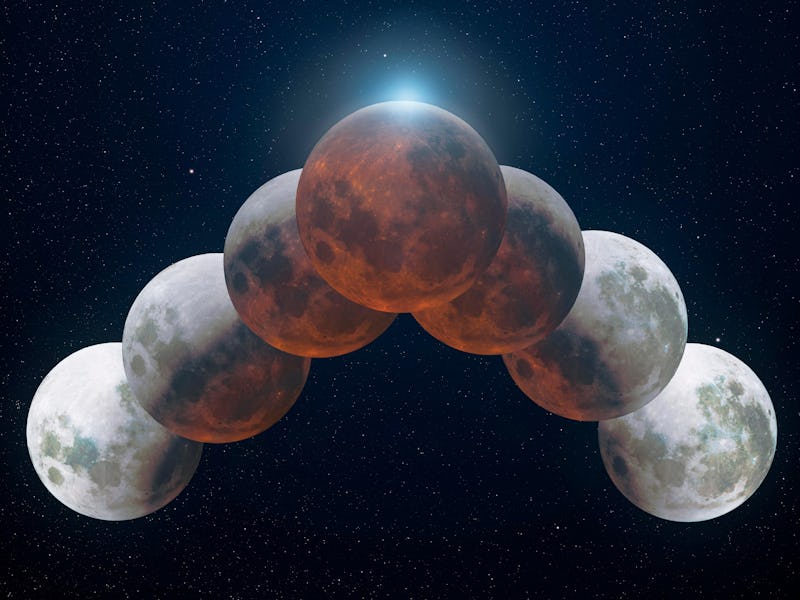May 2022 Total Lunar Eclipse: You need to see the first Blood Moon of the year
The site of a "Blood Moon" will startle some observers, but don't worry — it's just a chance cosmic alignment.

On May 16, the Full Moon will enter a total eclipse for around an hour and a half, causing a cosmic phenomenon known as a Blood Moon. The event coincides with a supermoon, a term for the Moon at the closest point in its orbit to Earth coinciding with Full or New Moon phases.
Contrary to popular belief, a supermoon will not appear much more prominent in the sky, yet it will be slightly brighter in many cases — but not during an eclipse.
Here’s the Inverse guide to these two concurrent lunar events you don’t want to miss!
What is a Blood Moon?
As frightening as it may look, the Blood Moon is nothing to fear. On the night of total lunar eclipses, the Moon turns a bloody red for a short time due to a conjunction of the positions of the Sun, Earth, and Moon. The bright red appearance is caused by the shadow of Earth across the surface of the Moon.
Picture the Moon orbiting the Earth, and then zoom out to the Earth orbiting the sun. Having no light of its own, we see the moon in the sky because it is reflecting sunlight. If Earth lines up perfectly with the Sun on one side of the planet and the Moon directly on the other side, it will prevent the moon from receiving the sunlight. The light from the Sun will bend around Earth, causing only the longest wavelengths of red to reach the moon. The result is a terrifyingly red-tinted moon for a short time. This effect is known as Rayleigh scattering.
When everything lines up just right, the shadow of Earth covers the Moon completely.
What time is the lunar eclipse in May 2022?
Make sure to mark your calendar and set a reminder on your phone! Those in the Eastern parts of the US, South America, and Canada will have the greatest show, yet those in the Central US and parts of South America will be able to see most of the spectacle as well.
- The Earth’s shadow will begin to cover the moon on May 15, starting at 10:28 p.m. Eastern, and slowly cast a shadow
- At 11:29 p.m. Eastern, totality will begin, allowing only red wavelengths to reach the Moon. Totality will last until 12:53 a.m. Eastern, giving almost an hour-and-a-half to enjoy the cosmic show.
- The greatest eclipse will be at 12:11 a.m. Eastern. This is the best viewing opportunity for the Blood Moon.
Where is the May 2022 lunar eclipse visible?
The Eastern US, Canada, and South America are the prime viewing locations for the entire event. The eclipse will still be visible in Western Africa, the western United States, and South America, but only portions of those areas.
The Western US will not see the eclipse's beginning, but totality may be visible depending on location. Meanwhile, those in Western Africa and Western Europe may only catch the start of totality before the moon sets.
Will you be in the path?
How many eclipses are there in 2022?
There will be four eclipses visible on Earth this year. The other three are:
- The partial solar eclipse on April 30 which was visible in the South Pacific
- A partial solar eclipse on October 25 visible in Europe, the Middle East, Western Asia, and Northeastern Africa
- The November 7 total lunar eclipse visible in Australia, Oceana, and North America, with partial eclipses visible in other areas
When was the last lunar eclipse?
If you are fortunate enough to be in a location where the total lunar eclipse is visible on May 16, make sure to view it, as they do not come around often. The last total eclipse visible in the Western US was on May 26, 2021. However, there was a deep partial lunar eclipse on November 18, 2021.
When is the next lunar eclipse?
The next lunar eclipse will not be until November 7-8, 2022. The total eclipse will be best visible on West Coast US as East Coast will miss the finale with totality beginning as the sun rises.
If you miss this eclipse due to weather or location, you will have to wait. The next total lunar eclipse of 2022 will not be until November 7. Unlike the May lunar eclipse, the November 2022 eclipse will be near apogee, the Moon’s furthest point from Earth.
People in North America, Europe, Asia, Australia, South America, Pacific regions, the Arctic, and Antarctica will all get to view part of this eclipse. Make sure to mark your calendars! Of course, Inverse will have your guide to the event as the time gets closer.